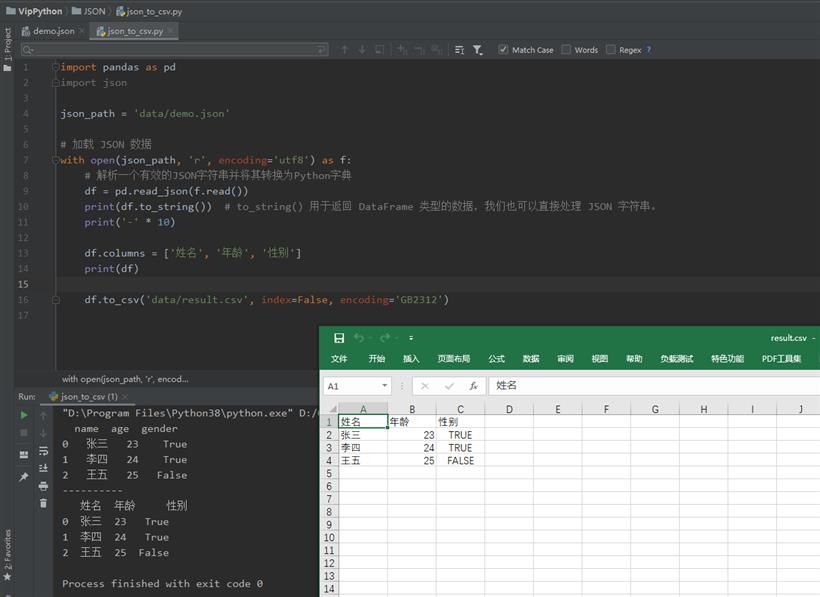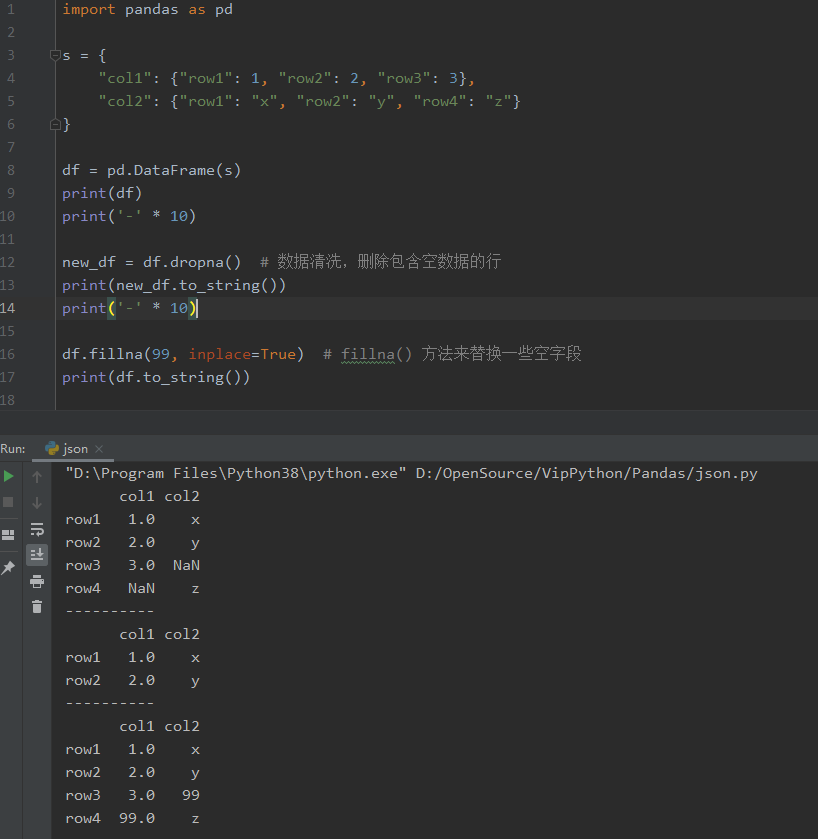Pandas 可以很方便的处理 JSON 数据
demo.json
[
{
"name":"张三",
"age":23,
"gender":true
},
{
"name":"李四",
"age":24,
"gender":true
},
{
"name":"王五",
"age":25,
"gender":false
}
]
JSON 转换为 CSV
非常方便,只要通过 pd.read_json 读出JSON数据,再通过 df.to_csv 写入 CSV 即可
import pandas as pd
json_path = 'data/demo.json'
# 加载 JSON 数据
with open(json_path, 'r', encoding='utf8') as f:
# 解析一个有效的JSON字符串并将其转换为Python字典
df = pd.read_json(f.read())
print(df.to_string()) # to_string() 用于返回 DataFrame 类型的数据,我们也可以直接处理 JSON 字符串。
print('-' * 10)
# 重新定义标题
df.columns = ['姓名', '年龄', '性别']
print(df)
df.to_csv('data/result.csv', index=False, encoding='GB2312')
 简单 JSON
从 URL 中读取 JSON 数据:
简单 JSON
从 URL 中读取 JSON 数据:
import pandas as pd
# 堆代码 duidaima.com
URL = 'https://static.runoob.com/download/sites.json'
df = pd.read_json(URL) # 和读文件一样
print(df)
输出:
id name url likes
0 A001 菜鸟教程 www.runoob.com 61
1 A002 Google www.google.com 124
2 A003 淘宝 www.taobao.com 45
字典转化为 DataFrame 数据
import pandas as pd
s = {
"col1": {"row1": 1, "row2": 2, "row3": 3},
"col2": {"row1": "x", "row2": "y", "row4": "z"}
}
df = pd.DataFrame(s)
print(df)
print('-' * 10)
new_df = df.dropna() # 数据清洗,删除包含空数据的行
print(new_df.to_string())
print('-' * 10)
df.fillna(99, inplace=True) # fillna() 方法来替换一些空字段
print(df.to_string())
输出:不同的行会用 NaN 填充
col1 col2
row1 1.0 x
row2 2.0 y
row3 3.0 NaN
row4 NaN z
----------
col1 col2
row1 1.0 x
row2 2.0 y
----------
col1 col2
row1 1.0 x
row2 2.0 y
row3 3.0 99
row4 99.0 z
 内嵌的 JSON 数据
内嵌的 JSON 数据
nested_list.json 嵌套的JSON数据
{
"school_name": "ABC primary school",
"class": "Year 1",
"students": [
{
"id": "A001",
"name": "Tom",
"math": 60,
"physics": 66,
"chemistry": 61
},
{
"id": "A002",
"name": "James",
"math": 89,
"physics": 76,
"chemistry": 51
},
{
"id": "A003",
"name": "Jenny",
"math": 79,
"physics": 90,
"chemistry": 78
}
]
}
运行代码
data = json.loads(f.read()) 使用 Python JSON 模块载入数据。
json_normalize() 使用了参数 record_path 并设置为 ['students'] 用于展开内嵌的 JSON 数据 students。
import pandas as pd
import json
# 打印出结果JSON结构
with open('data/nested_list.json', 'r') as f:
data = pd.read_json(f.read())
print(data)
# 使用 Python JSON 模块载入数据
with open('data/nested_list.json', 'r') as f:
data = json.loads(f.read())
# 展平数据-- json_normalize() 方法将内嵌的数据完整的解析出来:
df_nested_list = pd.json_normalize(data, record_path=['students'])
print(df_nested_list)
image
import pandas as pd
import json
data_path = 'data/nested_list.json'
print(('-' * 10) + ' 连同上级JSON值一起显示')
# 使用 Python JSON 模块载入数据
with open(data_path, 'r') as f:
data = json.loads(f.read())
# 展平数据
df_nested_list = pd.json_normalize(
data,
record_path=['students'],
meta=['school_name', 'class']
)
print(df_nested_list)
 复杂 JSON
复杂 JSON
该数据嵌套了列表和字典,数据文件 nested_mix.json 如下
nested_mix.json
{
"school_name": "local primary school",
"class": "Year 1",
"info": {
"president": "John Kasich",
"address": "ABC road, London, UK",
"contacts": {
"email": "admin@e.com",
"tel": "123456789"
}
},
"students": [
{
"id": "A001",
"name": "Tom",
"math": 60,
"physics": 66,
"chemistry": 61
},
{
"id": "A002",
"name": "James",
"math": 89,
"physics": 76,
"chemistry": 51
},
{
"id": "A003",
"name": "Jenny",
"math": 79,
"physics": 90,
"chemistry": 78
}]
}
import pandas as pd
import json
# 使用 Python JSON 模块载入数据
with open('data/nested_mix.json', 'r') as f:
data = json.loads(f.read())
df = pd.json_normalize(
data,
record_path=['students'],
meta=[
'class',
['info', 'president'], # 类似 info.president
['info', 'contacts', 'tel']
]
)
print(df)
id name math ... class info.president info.contacts.tel
0 A001 Tom 60 ... Year 1 John Kasich 123456789
1 A002 James 89 ... Year 1 John Kasich 123456789
2 A003 Jenny 79 ... Year 1 John Kasich 123456789
[3 rows x 8 columns]
读取内嵌数据中的一组数据
nested_deep.json
{
"school_name": "local primary school",
"class": "Year 1",
"students": [
{
"id": "A001",
"name": "Tom",
"grade": {
"math": 60,
"physics": 66,
"chemistry": 61
}
},
{
"id": "A002",
"name": "James",
"grade": {
"math": 89,
"physics": 76,
"chemistry": 51
}
},
{
"id": "A003",
"name": "Jenny",
"grade": {
"math": 79,
"physics": 90,
"chemistry": 78
}
}]
}
这里我们需要使用到 glom 模块来处理数据套嵌,glom 模块允许我们使用 . 来访问内嵌对象的属性。
第一次使用我们需要安装 glom:
pip3 install glom -i https://pypi.tuna.tsinghua.edu.cn/simple
import pandas as pd
from glom import glom
df = pd.read_json('nested_deep.json')
data = df['students'].apply(lambda row: glom(row, 'grade.math'))
print(data)
输出:
0 60
1 89
2 79
 闽公网安备 35020302035485号
闽公网安备 35020302035485号
 闽公网安备 35020302035485号
闽公网安备 35020302035485号


